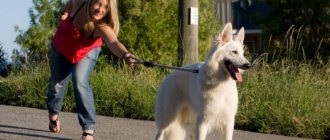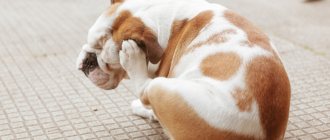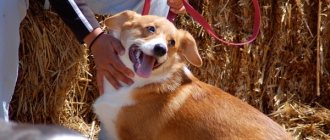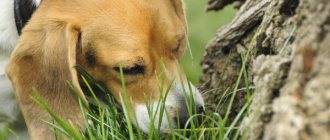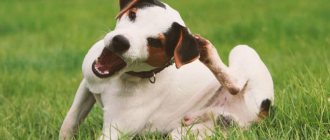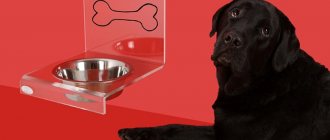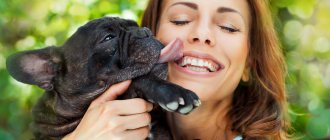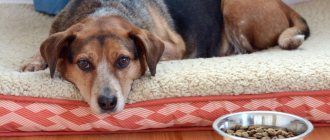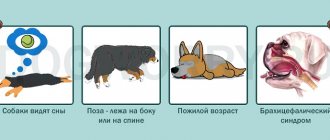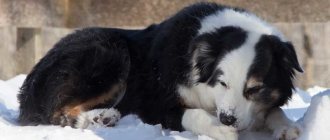5 / 5 ( 1 voice )
Sneezing is the body’s protective reflex when an irritant enters the nasal cavity. In both humans and dogs, the mechanism works the same way: air is forcefully pushed out of the nose, clearing the sinuses. But the problem does not always lie in dust, pollen or feathers. Often a harmless sneeze is a symptom of a cold or viral disease.
Symptom: the dog is sneezing, what to do
If the dog got out from under a dusty bed or from a dark closet, then sneezing is a normal reaction to dust and cobwebs. If a baby inhales pollen from a flower or the owner’s perfume, he is 100% likely to cough. Animals have a similar reaction to tobacco smoke.
Some pets sneeze to encourage the owner to play or otherwise draw attention to themselves.
But if the dog is breathing poorly or sneezing for no reason, you should take a closer look at its nose. There may be something larger than sand stuck in your nostrils, such as a blade of grass or an insect. Objects are removed by endoscopy, and rinsing with water or anti-inflammatory drops (Divopride) is prescribed.
The main difference between the painful condition and a simple reflex is the presence of whitish or yellowish discharge on the nose. This condition can be caused by allergies, colds, polyps, oncology, hypothermia or helminthic infestation. Depending on the cause, there will be different symptoms.
Prevention measures
With proper maintenance and a balanced diet, the animal has a strong immune system, so it will not have any health problems. It is important to provide the correct menu for your pet, long and regular walks and physical activity. The dog must be vaccinated on time and also examined by a veterinarian.
Note! The pet must be kept in a clean room, which is regularly treated with disinfectants. This will relieve the animal from dust allergies and infections.
Regardless of the reason why the dog started sneezing, you need to try to help the animal, since it cannot always cope on its own. It is not recommended to start treatment at home for a cold or infection, as the dosage of medications may be miscalculated. The same applies to the use of folk methods of struggle.
Sneezes and snorts
Snorting is a sign that your pet is trying to clear his sinuses . If the lobe is clean and there is no discharge, then the cause lies in a foreign object. In this case, a prolonged act of sneezing and other symptoms are noted:
- Anxiety (the dog rubs its nose with its paws);
- Difficulty breathing (the dog cannot draw in air and snorts);
- Coughing attacks are possible when the posterior connective tissue is blocked.
If your dog is sneezing heavily for several days, there is a reason to see a veterinarian. A single or double sneeze should not cause panic among owners.
The veterinarian will surgically remove the object. After which antiseptics (Anadin) and a course of antibiotics (Polydex) will be prescribed. It is important to show your pet to a doctor after treatment to conduct a final rhinoscopy to confirm the fact of recovery.
Another problem that causes a similar reaction is severe bruising. In this case, pain will occur when you press the spout. Injury can be caused by a sharp branch, a cat, or even a bee sting.
All cuts, injections or bruises of the lobe are very painful, because important receptors are located on the tailed nose. The owner can treat the edges with a solution of sodium permanganate or brilliant green, and seal it with a band-aid there so as not to close the nostrils.
Sneezes and coughs
Sneezing and coughing attacks in dogs look frightening, as if the animal is choking, convulsively gasping for air, and jerking its head. For an unprepared owner, such a picture will cause horror and panic, but there is no need to worry. Most likely, the pet has caught a cold.
His only symptom may be occasional sneezing or frequent coughing. But sometimes the disease takes on a different form:
- Heat;
- Chills;
- Lack of appetite;
- Lethargy.
In this case, the owner can independently cope with the problem:
- With children's "Pinosol", drop 1-2 drops into each nostril 3 times a day.
- When crusts appear, hydrogen peroxide diluted with water is dripped (1-2 drops each).
- Cough is treated with Pertussin children's syrup (no more than 1-2 teaspoons per day), Glyceram or Mucaltin.
If the cold is caused by hypothermia, then you need to take care of the warmth of the room in which the pet is located. It is better to put the heating pad in the sunbed for a while. From now on, you need to dress your dog in protective warm overalls and boots. There should be no drafts or temperature changes in the house due to air conditioning.
Heart problems
An older dog sometimes sneezes and coughs due to heart failure. This symptom appears especially clearly in nervous animals during periods of severe shock. Miniature poodles and pinschers are especially susceptible to this reaction. Stress is very dangerous for such dogs. Therefore, you need to monitor the condition of their cardiovascular system. It is necessary to periodically undergo a preventive examination at a veterinary clinic. Animals that begin to sneeze should have a cardiogram done to rule out heart disease.
The dog often (constantly) sneezes - what is the reason?
Why a dog sneezes a lot and often is a complex question. Sometimes the “foreign object” is a cancerous tumor or benign polyps. In this case, removal of damaged tissue, chemotherapy and recovery are required. Without rhinoscopy and tests, it is impossible to identify the cause of regular sneezing.
Chronic runny nose can cause systematic hypothermia. For example, if the dog is kept in a kennel or enclosure and does not have warm bedding or heating.
Sometimes sneezing is a breed trait. Yorkshire terriers, for example, can sneeze “in the nose,” that is, in the opposite direction. Other dogs with a short, straight muzzle are also prone to this reflex.
Reverse sneeze syndrome
A condition in which a dog convulsively sucks in air is called reverse sneezing. The act of sneezing involves sharply exhaling air through the nose. With reverse sneezing, the opposite process occurs. These convulsive breathing movements are explained by the fact that part of the elongated soft palate is sucked into the windpipe when inhaling, and thus the dog tries to clear the airways. A tight collar or a strong-smelling chemical can cause reverse sneezing. Dogs of small breeds with a small trachea and a short muzzle (brachycephalic) are especially susceptible to this disorder.
Similar movements appear if the dog is choking and reflexively tries to push the foreign body out of the windpipe. In most cases, this condition occurs in healthy dogs, but sometimes it may indicate the presence of worm larvae or polyps in the windpipe. So, if reverse sneezing occurs, it is recommended that your pet be examined by an experienced veterinarian.
Sneezing is a physiological process that allows you to get rid of foreign particles or microorganisms that irritate the nasopharynx area. But, at the same time, very often sneezing is a symptom of serious diseases of the respiratory system, the consequences of which can be serious. Therefore, if there is any suspicion of pathology, it is recommended to undergo a diagnostic examination at a veterinary center.
The dog has snot (runny nose) and is sneezing - how to treat it
If your dog is sneezing and sniffling, it most likely has allergies . In this case, other symptoms may appear: itching, swelling of the pharynx, discharge from the ears, increased lacrimation or salivation, in especially severe cases - anaphylactic shock, epilepsy.
Read a detailed article on this topic: “Symptoms and manifestations of allergies in dogs: we figure out what causes them and how to treat them.”
To treat an allergic reaction, you must first find out the cause of its occurrence and identify the irritant. Most often, dogs suffer from food allergies, then it is worth removing chicken, wheat, corn from the diet or changing dry food to grain-free holistic food. If the irritation is caused by pollen, it is enough to limit your pet’s access to flowers. To speed up the healing process, antihistamines are prescribed.
| Drug name | Approximate cost (rubles) per package | Mode of application |
| Diazolin | 20-30 | For older and small dogs, 1 time per day, the children's dose indicated in the instructions |
| Suprastin | 120-150 | 1 time per day (injection or tablet), no more than 2 mg of active substance per 1 kg of animal |
| Allervet (1% for small dogs, 10% for large dogs) | 140-180 | A strong drug is used only to prevent an allergic attack at the rate of 1 ml per 5 kg |
| Desloratadine | 70-90 | 2 mg per 1 kg (vet consultation required) |
| Tavegil | 160-200 | 1 tablet per 60 kg dog weight, 1 time per day |
The second reason for a runny nose in a dog is rhinitis. This is an inflammation of the nasal mucosa caused by any of the above reasons: allergies, hypothermia, or foreign objects. The disease initially manifests itself with sneezing and clear discharge from the nostrils. As the disease progresses, it brings slimy, purulent snot that seals the nasal passages.
Antibacterial or anti-inflammatory drops cope well with the symptoms of rhinitis: “Bresol”, “Divopride”, “Maksidin”.
If your nose is cracked, Vaseline will help. If the lobe is too wet, it requires drying - streptocide powder. If a virus or infection is involved in the disease, you cannot do without antibiotics.
Herbal decoctions and infusions soothe irritated mucous membranes: chamomile, coltsfoot, string. They are dripped 2-3 drops into each nostril.
If a dog sneezes with pus and smells from his nose, then the disease is more serious than a cold. Purulent discharge, crusts around the nose, a sharp increase in temperature are signs of a dangerous viral disease - distemper . You can only protect yourself from it with regular vaccinations.
The infection is especially dangerous for puppies, pets with low immune resistance (due to poor nutrition, cold and damp conditions). It is difficult to cure an animal from distemper. More common is a transient death due to disruption of the central nervous system.
Read a useful article on the topic: “Dangers of cold weather - signs, symptoms, prevention of colds.”
Causes of sneezing in dogs
Allergies (most often to environmental components - dust, pollen and many other irritants). The dog itches, sneezes, and clear mucus (snot) comes out of both nostrils. In addition to sneezing, the dog's eyes are leaking.
Possible swelling, difficulty breathing, even to the point that the dog is suffocating. There may be attacks of “sneezing” upon contact with an allergen. For example, if a pet has such a reaction to the pollen of a plant, then attacks become more frequent during a walk.
Infections , that is: viruses, bacteria, fungi. These factors can cause a huge list of diseases, the most common being canine distemper, adenovirus, coronavirus (respiratory form) and others...
Usually accompanied by lethargy, coughing and sneezing for a long time. The nose is stuffy, crusts form, conjunctivitis (discharge from the eyes). Over time, you can hear wheezing in the chest, the temperature rises, the nose is dry and warm.
In viral diseases, the snot is usually watery and transparent, and may thicken and become cloudy as the disease progresses.
With fungal infections, the discharge is viscous and smearing. This pathology is very painful for dogs, in severe cases it leads to deformation of the skull bones.
Foreign body in the nose. It could be a blade of grass or even a small stone. This usually happens to animals that constantly sniff the ground. The dog feels that something is preventing it from breathing normally and begins to snort, the receptors in the nose become irritated and it sneezes.
In cases where the pet is unable to get rid of the object in the nose on its own and it remains there for a long time, inflammation and swelling develop, which makes breathing even more difficult for the pet.
Local irritation. This happens in cases where the pet inhales caustic substances, such as smoke, perfume, or something from household chemicals. In this case, the symptoms begin to appear very quickly and sharply - the dog sneezes, rubs his nose with his paws, the discharge in this case is liquid and transparent.
Very severe inflammation develops. Sometimes there can be a chemical burn to the mucous membrane if the pet has inhaled some household chemicals.
Injury. The dog can get injured on its own, or as a consequence of surgical interventions, and sometimes because of a foreign object or an unsuccessful attempt to pull it out.
In this case, the dog sometimes sneezes blood from the nose, while it experiences pain, jerks its head, and backs away.
Tumor or polyp (in one word - neoplasm). It manifests itself in the same way as a foreign body in the nasal cavity, which interferes with normal breathing, but becomes chronic and responds little to treatment. Therefore, it makes no sense to start treating if you have not eliminated the cause of the disease - you need to remove the tumor.
Otherwise, you will relieve swelling and local irritation only for a while. Meanwhile, the tumor may increase in size. If these were polyps, then even after removal they tend to grow again, therefore, periodic examinations will be needed to ensure timely removal and prevent the growth of new polyps.
Parasites (ticks, fleas, helminths). Firstly, animals have a specific allergic reaction to the saliva of a flea or tick. Secondly, it is important to know that helminths (parasitic worms) live not only in the intestines.
There are also pulmonary helminthiases, in which case the parasites live in the bronchi of the lungs and can move up the respiratory tract. In this case, irritation of the mucous membrane occurs, the dog coughs and sneezes. Sometimes you can even observe that small worms fly out along with the mucus.
Diseases not related to the respiratory (respiratory) system - diseases of the urinary system, gastrointestinal tract, etc., can also cause sneezing. And this happens through a weakened immune system, the body becomes less resistant to bacteria and viruses, nasal discharge appears, and therefore sneezing.
In this case, you can cure a runny nose, but it will soon return until the underlying disease disappears and immunity is restored.
Frontal sinusitis is an inflammation of the frontal sinus, similar to sinusitis in humans. As a rule, it is caused by infections (both viral and bacterial etiology), or as a complication of other diseases of the respiratory system.
With this disease, the dog sneezes and produces a large amount of mucus. At the beginning of the disease, the exudate (discharge) is liquid and transparent, and the further the disease progresses, the denser and greener the discharge becomes. You shouldn’t let the disease get to this point.
Stress, anxiety, a tight collar - in these cases, sneezing is a normal process that does not require concern.
Dog sneezes blood
Blood signals a violation of the integrity of the capillaries. Either a foreign object damaged the skin, or the blood vessels burst from pressure due to overheating. If the bleeding does not stop, the pet should be seated with its head pointing down. The carrier is packed with cold (ice, a bottle of water, frozen semi-finished foods). After this, the pet must be taken to the veterinarian.
Another possible cause is chemical vapor poisoning . This often happens when a dog finds rat poison and tries to sniff it. Or at home he comes across detergents. In this case, the owner must urgently show the dog to a doctor.
Sometimes blood appears when sneezing due to prolonged rhinitis.
Treatment
Treatment should be prescribed by a veterinarian after an in-person examination of the dog.
Because in order to take action for the dog’s recovery, it is necessary to determine the cause of the disease, and this is not always possible at home.
What to do before visiting the clinic?
First, examine your nasal passages. It is advisable to use a flashlight to illuminate your nose. This way you can detect foreign objects if there are any. Also, you will immediately see if there is swelling and redness; these are the first signs of inflammation.
Remove dirt and crusts around the nose using a cotton pad moistened with plain warm water.
To reduce inflammation, it is safe to use Anandin drops or a 0.15% Maksidin solution, one drop in each nostril. These drops are a complex preparation against bacteria. Helps relieve swelling and promotes tissue healing.
If after a couple of days the sneezing does not go away, does not become weaker, and the dog exhibits other symptoms - lethargy, loss of appetite, fever, you should immediately consult a doctor. There is always a danger that the dog has contracted a viral infection, which is very dangerous for the pet’s life!
Sneezes and grunts
Grunting is a typical sound made by Mastiffs, Bulldogs and related breeds (even Pugs and Pekingese). The reason is the special structure of the muzzle and respiratory apparatus. But if grunting is accompanied by coughing, shortness of breath and sneezing, this is a reason to visit the veterinarian.
Such reflexes are the cause of helminthic infestation. Roundworms settle not only in the intestines, but also live throughout the body. If the pet is restless, often vomits, scratches the anal passage, while sneezing and grunting, then there is only one conclusion - infection with helminths. Routine cleaning should be carried out using the usual preparations.
A deadly pathology is tracheal collapse (softening of the cartilaginous rings of the trachea, blocking of the larynx, lowering the softening process to the bronchi). The disease is genetic and incurable.
Sneezing and coughing are not a reason to panic. If such attacks occur regularly, the owner knows what causes them and how to get rid of them, then there is no point in going to the clinic. But if the pathology is primary, then it is better to contact a veterinarian to find out the cause.
At-risk groups
Most often, sneezing can be observed in animals kept outside, since they are forced to be in drafts and are more often exposed to hypothermia than other dogs.
Brachycephalic breeds such as Pugs, Pekingese, Boston Terriers, Bulldogs, Shih Tzus, Boxers and others. Due to the structure of their skulls, they can often be observed grunting, snoring, snoring, and sneezing, and they are also often observed to have reverse sneeze syndrome.
This always indicates that the animal is having difficulty breathing. People have made such a pathology a breed feature. You don't need to close your eyes to it. If symptoms occur frequently and interfere with the dog’s normal life, you should consult a veterinarian. You may need surgery to make breathing easier.
